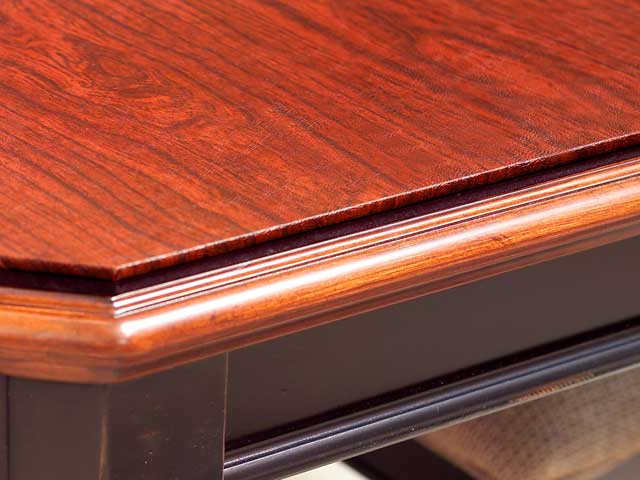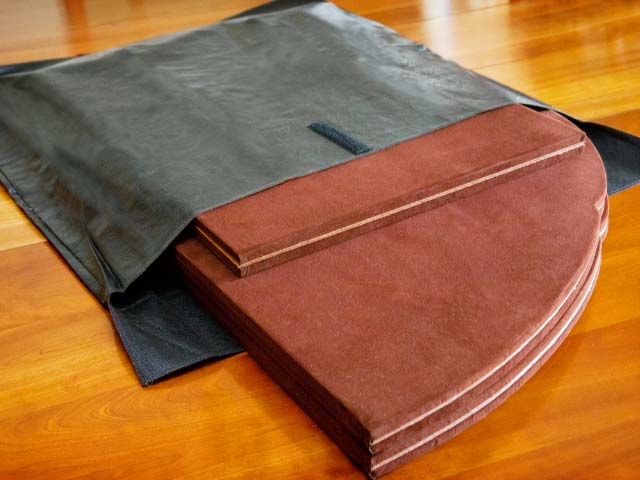Note: the browser you are using is an older version which cannot display this site accurately. For best results, upgrade to a new version of Chrome, Firefox, Safari or Internet Explorer.
Please enable JavaScript in your browser to use this site fully, or call us at 1-800-541-0271.
How to Clean a Table Pad
 We have a pad that we have left on a table for twenty years and it looks brand new. The key to cleaning a table pad is just a clean warm dishrag to wipe down the vinyl after use; or if something has dried overnight, a mild solution of dishwashing liquid would be sufficient. You never want to use harsh cleaners or any type of vinyl cleaner or shining product: these products are made from chemicals that can react with the other chemicals that were used to make up your vinyl top, and it is possible for them to disintegrate the vinyl.
We have a pad that we have left on a table for twenty years and it looks brand new. The key to cleaning a table pad is just a clean warm dishrag to wipe down the vinyl after use; or if something has dried overnight, a mild solution of dishwashing liquid would be sufficient. You never want to use harsh cleaners or any type of vinyl cleaner or shining product: these products are made from chemicals that can react with the other chemicals that were used to make up your vinyl top, and it is possible for them to disintegrate the vinyl.
The bottom of your pad should never be touched. To insure the cleanliness of the bottom of your pad, simply dry dust your table with a dry soft flannel rag or a Swiffer before sliding your pad on. Some people slide the pad onto a dusty table, or they do the opposite and polish the table before they put their pad on. Consequently, the back of the pad becomes like a tack rag and eventually the backs of old pads can look pretty seedy.
Our recommendation is to select a warm or dark bottom color. Our experience suggests the darker colors are more practical because they show dirt the least over time.
How to Properly Store a Table Pad
The #1 Reason Table Pads Are Replaced
The number one reason why consumers need to replace their table pads is not the usage, but that they are stored improperly. The proper way to store a pad is in its original shipping carton or in a table pad storage bag. If you store your table pads in the box, they may be stored in any position, upright, at an angle, cockeyed, or flat. If you choose to store your pads in a bag, they should only be stored flat.
The Stress Area of the Table Pad
A table pad has a stress area, and this is the fold: sometimes referred to as the hinge, but the hinge is not a metal or mechanical hinge, it is a fabric hinge very similar to the hinge on a hard cover book. If you are familiar with good books, they recommend storing them between bookends or flat; the reason is to protect the fabric binding or book hinge. If you lean a book, the outside cover wants to rest so it eventually droops to the shelf, and in time breaks down this binding. Because the table pad hinge is also made of fabric, and the panels are much heavier than a book, more care is needed to properly protect this similar stress area.
If You Store Your Table Pads in a Box
If you store your table pads in the original shipping carton, the bottom of the box is like the shelf and the sides of the box are like the book ends, always keeping your pad perpendicular to a flat surface. You may now store your pads any way you want to: upright, at an angle, cockeyed or flat.
If You Store Your Table Pads in a Pad Bag
 When storing your table pads in a pad storage bag, they should be kept flat, under a bed, a couch, or on a shelf. Choosing to store them flat will also protect the fold or hinge.
When storing your table pads in a pad storage bag, they should be kept flat, under a bed, a couch, or on a shelf. Choosing to store them flat will also protect the fold or hinge.
Table Pads Should Be Stored at a Constant Temperature
We recommend storing your table pads on the first or second floor of your home and never in a hot attic, moist basement, or garage. And never store them in a furnace room with a water tank. In 35 years, we have replaced many table pads because the water tank broke, flooded the room and drowned the table pads at the same time.

